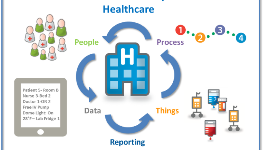The Internet of Health Things Forecast $117B in 2020
The Internet of Health Things has become a catchphrase for everything from self-driving cars to tiny sensors we swallow like pills. Regardless of the hype, the next wave of innovation will clearly leverage connectivity and the Internet deeply and in ways never before possible. From a practical standpoint, this means millions of new “Internet of Health” devices will be added to health systems over the next five years. According to a report from MarketResearch.com, the healthcare IoT market segment is poised to hit $117 billion by 2020
With this growth comes greater complexity. Regardless of the specific new “Thing,” what are the key attributes to keep in mind in order to grow new solutions safely into large-scale solutions? First is clearly security, which cannot be tacked on later. New ways of securing tiny devices are available, but the products must be carefully designed to be secure–it’s more than just encryption, it’s how to maintain trust and privacy. Trust means knowing the identity of the data so you can act with confidence.
Second is manageability. The cost of the Internet of Health can be dominated by operating costs if the systems are not designed like the best enterprise tools for easy commissioning, updating and operation. Especially with IoT you have to be smart about large numbers of devices possibly distributed across broad geographies.
And finally, just like the best cloud-based technology, IoT systems should interoperate with your existing technology through clear and standard APIs. It should be easy to flow information across a well-designed IoT system and into your favorite connected application from report generators to machine learning data analysis tools.
Another dimension of IoT is its effect on existing devices and practices not just on new products. By using new sensors, for example, we can now measure and learn more deeply and more completely than was possible before, even if we are using existing equipment. Ease of deployment is key.
By using software-driven techniques, we can synthesize results from multiple sources (sometimes called “sensor fusion”) to yield new insights faster than ever. The results can be as straightforward as better operations by using predictive analytics to avoid equipment failure to new ways of improving the patient experience by sensing traffic flow, finding the right equipment faster, or lowering the cost of care through better environmental management.
Category: Uncategorized

